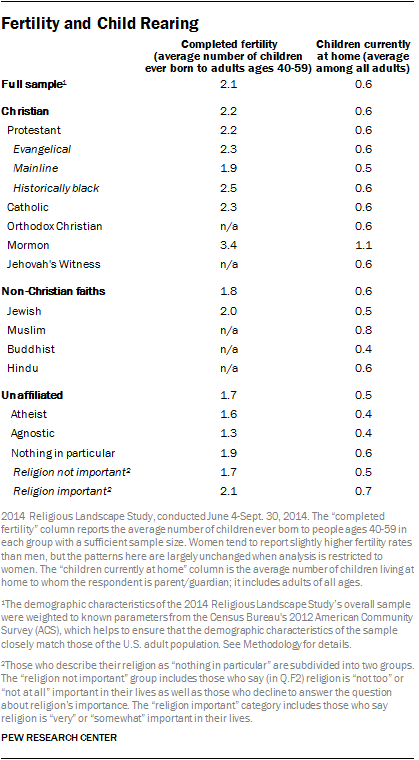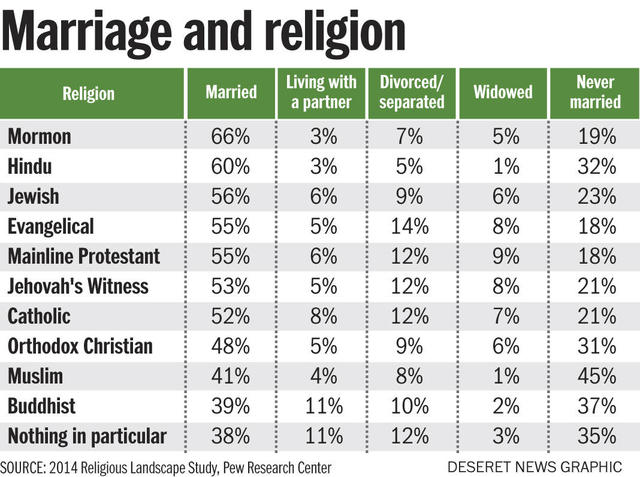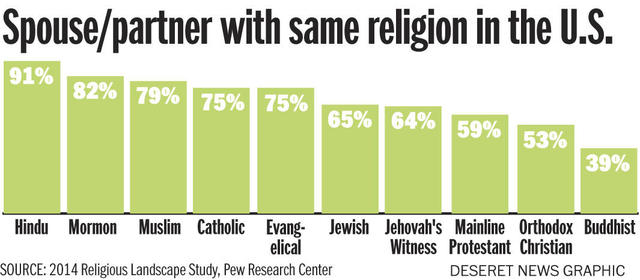The Pew study on religion is a massive undertaking. Pew interviewed 35,000 adults on religious habits in English and Spanish. The study is not perfect, but it seems to be widely recognized as the best, most comprehensive study out there on the religious practices of Americans.
For Mormons, there is some good news but also plenty of worrisome news.
First, the good news. Mormons still have big families.
Mormons have significantly more kids than any other religious group. This of course is good news for the future. Kids born Mormons are more likely to stay in the Church.
Mormons are also more likely to be married and divorce is relatively rare.
Mormons are also very likely to marry other Mormons (temple marriages are a good thing and partners who share a religion are more likely to stay married).
Meanwhile, the percentage of total people in the United States who are Mormon was pretty stable from 2007 to 2014. IN 2007 it was 1.7 percent, and in 2014 it was 1.6 percent.
The big news from the survey was the precipitous drop in the Christian population in the U.S.
As this story notes:
The biggest change is the sharp drop in Americans who identify as Christian, from 78.4 percent in 2007 to 70.6 percent last year. Christianity’s downsizing “is big, it’s broad, and it’s everywhere,” said Alan Cooperman, Pew’s director of religion research. “The decline is taking place in every region of the country, including the Bible Belt.”
The sharpest declines are among mainline Protestants (14.7 percent, from 18.1 percent in 2007) and Roman Catholics (20.8 percent, from 23.9 percent), with a much smaller drop in evangelical Protestants (25.4 percent, from 26.3 percent).
Where are those Christians going? To the “nones,” mostly — embracing atheism, agnosticism, vague spirituality, and indifference. The number of atheists (3.1 percent) and agnostics (4 percent) doubled, and there are more total “nones” (22.8 percent) than Catholics, or than United Methodists, Presbyterians, and Evangelical Lutherans combined. The number of non-Christian religious also grew slightly, to 5.9 percent from 4.7 percent, with most of the growth among Hindus and Muslims.
The aversion of younger people to organized Christianity is a big factor, but people in all demographics are leaving the churches.
It is worth noting that the membership numbers of the more conservative dominations are pretty stable. It is the liberal “mainline” Protestant churches and the Catholic church that are losing members.
This article has many things to ponder about the total Christian population. Give it a read. To sum up: evangelicals are doing OK, mainline Christian groups are in decline, and the Catholic church is also in decline. The number of people with no religion is way up.





New Post: A few thoughts on the Pew study of religion: The Pew study on religion is a massive und… http://t.co/HUr6wWpIt8 #LDS #Mormon
TheMillennialStar: A few thoughts on the Pew study of religion http://t.co/H0VloK3stt #lds #mormon
I discussed the Pew data over at my blog too. I’m not sure I’d say the Evangelicals are doing alright. They increased in absolute numbers but relative to the US population they dropped a full percentage point. The drop in Catholicism ought be very troubling to Catholics since it’s a drop despite Catholic immigration.
The change in Mormon population (1.7% to 1.6%) is not significant statistically since their error appears to be ±1.5 million or there abouts. With a small population of Mormons that means they have a lot of noise. Their figures are also higher than the ARIS self-identification survey which (up to the last data) had us remaining around 1.4%.
Interesting information, Geoff. Thank you for posting. I clicked through to the Christianity Today article, and noted that they try really hard to never actually mention Mormons…
And Clark, thank you for the link to your post about the data.
If every Mormon I personally know either remained faithful or left the Church, it wouldn’t even show up in numbers such as these. Even so, I will continue to work in my tiny patch of God’s vineyard. And it is good to know that things are relatively strong overall, considering how small we still are and considering the sturm and drang that occurred in 2014 with those seeking female ordination and those actively attempting to destroy faith in the truth claims of the Church.
Alas, the Pew survey doesn’t show how many of us are dancing to music we hear versus those who are just dancing because the people around them are doing so. But at least they aren’t sitting outside on the curb proclaiming that music doesn’t exist.
Some may get annoyed at the incessant emphasis on family in the church, but numbers like these demonstrate that this emphasis has very positive benefits, particularly since fertility rates are falling dangerously low in other communities. And the church has managed to do this without overtly saying “have more children!”
As far as the church sliding as a percentage of the population, I’d be interested in hearing from a statistician how much growth the church actually has to experience in order to keep up with, or overcome general population growth. US population growth stands at .7% for the past few years. LDS worldwide growth rate was 1.92% in 2014, a significant drop from the huge gains in the mid and late 20th century where it was as high as 8.74 in 1989. If we continue only modest growth, are Mormons destined to keep sliding as a percentage of the population?
Nate, I do not find it surprising that the percentage of LDS in the U.S. population is stable now and that we are not converting as rapidly as we have in the past. Much of the Church’s growth is going to come outside of the U.S. and Canada and Europe, it seems to me. I hold hopes for an explosion of converts in China and India in the near future, but who knows if it will happen. I look at sayings like “the last will be first and the first will be last” and think that such things may also apply to the “last” countries who hear the restored gospel. In any case, the Church is very healthy and is led by the Savior, so all will be good in the end.
Nate one thing to keep in mind that most of the gains in LDS population up to the 90’s were due to opening up huge new areas as the Church went international. Also note that often retention was quite bad. For instance the high growth rate in the late 90’s was in large measure due to massive baptizing in Latin America with questionable emphasis on retention. Those days are never coming back.
I do think there are some worries with missionary work albeit primarily in Asia where Evangelicals are having a lot of success but our growth is anemic. But overall I think our growth isn’t bad at all – especially given the overall religious demographics at work in those countries. i.e. given how secular Europe is we shouldn’t be shocked the church grows slowly there.
LDS growth has dropped as US growth has dropped. While converts make up an important part of LDS growth, I think retention of those raised in the Church is key. Frankly given how much is demanded of Mormons I think we do pretty well there with retention somewhere between 60% and 70%.
One thing I do worry about is our missionary work. Dropping the age of missionaries will almost certainly affect effectiveness. Likewise there’s frankly a lot less time spent finding people than when I was a missionary in the late 80’s.
“For instance the high growth rate in the late 90’s was in large measure due to massive baptizing in Latin America with questionable emphasis on retention.”
That should have read
For instance the high growth rate in the late 80’s was in large measure due to massive baptizing in Latin America with questionable emphasis on retention.
By and large it appears that there were some questionable missionary practices down there that paralleled in someways the baseball baptisms in the 60’s and early 70’s in the northeastern US. You get large numbers but the vast majority really were never converted and drop out within weeks or at best months. So in many ways those high numbers people point to are distorted either by demographics (higher birth rates, newly opened areas) or bad missionary work focused on statistics rather than conversion.
I don’t know if I’d say it was so much an emphasis on statistics as an attitude of “Baptize whoever will come and let the chips fall where they may.” I was taught as a missionary that baptism meant the gift of the Holy Ghost, and this would handle the retention.
I think that belief was sincere but mistaken. Evidently the Brethren came to think so, too.
I would echo Kent’s memories of the 80’s in Latin America. There were few missionaries who baptized without seeing a sincere belief in the convert. The wards and branches had mostly newer converts also, and struggled to integrate many new members. Many people would experience hard times of some sort and then never come back. There were few who remembered them after several years and reactivation was much more difficult.
There were some questionable practices, but most were not at the policy level where missionaries were concerned.
My understanding was it wasn’t everywhere. Further unlike the baseball baptisms I don’t think that was the only problem. I think there were some structural issues relating to retention in latin America.
All that said I think it’s very hard for companionships to be baptizing 10+ per month and have good conversions in a place where the membership wasn’t already strong.
I should also note that the problem with the baseball baptisms was also a belief that if you exercised faith the retention would follow. i.e. the spirit would do the rest. While I know many had very bad feelings to some of the policies during that era I also think some of it has been exaggerated. The basic problem was thinking baptism was enough and the Lord would handle the rest.
The basic problem was thinking baptism was enough and the Lord would handle the rest.
Well, that, and the idea that the *missionary’s own* faith, obedience, etc. could overcome the agency of third parties in order to produce quantifiable results in terms of baptism, retention, and reactivation.
I firmly believe that the misuse of Grant von Harrison’s Drawing on the Powers of Heaven has set the LDS missionary effort back at least fifteen years.
that sounds about right, JimD.
I think there’s something to the missionary’s faith, although it’s hardly as simple as portrayed. I remember being terribly distraught on my mission because at my one year mark my MTC companion was already the top baptizer in mission history with 50 baptisms and I was yet to have my first. That despite working myself to death. Faith can’t make up for ignorance and of course the areas one is sent to differ. On the other hand most of those 50 went inactive soon after as they were likely more converted to my friend’s charisma and social skills. I was much weaker on the social skills and charisma but most of the people I baptized did stay active. (Actually was recently contacted by one amazing baptism via Facebook last month)
While van Harrison taught a lot of bad things, I’m more loath to rejected it all together. I think part of faith and revelation is learning to listen to how we have to work to change ourselves. That is I think sometimes we’re like the brother of Jared expecting God to do both the thinking and work for us. Instead he says what (in particular) do you want my help with. A lot is figuring out what we need to do. And frankly much of that is learning to relax, learning to be flexible, and learning to listen to the spirit better. But there were also things I learned from the von Harrison model that worked extremely well in practical terms.
I should hasten to add that I sincerely doubt that was my friend’s fault. Just that he was a very likable guy and people listened to him. But that’s different from really being converted. I think he was trying as hard as I was and was likely as distraught by the people who quickly fell away as I was by people not listening.
I looked at membership statistics and noticed that church growth has always outpaced world population growth as a percentage. And even if US church growth has slid in comparison to US growth, I don’t foresee a time when worldwide church growth will slide in comparison to world population growth. World population growth is steadily declining and will continue to do so. Even if the church keeps growing at a modest pace, we should continue to augment our piece of the pie.
If I understand correctly, “baseball baptism” refers to getting children to agree to baptism through fraudulent means. I served in South America in the late 80’s. There were stories of missionaries who employed some of those tools, but I am sure they were rare. Of course, I do not have first-hand experience with the actual baseball-baptism era. My perception is that baseball baptisms were done with the knowledge and approval of mission presidents and higher authorities. (If anyone knows more, correct me.) I know for a fact, though, that my mission president would have exploded if he had found out that missionaries were using manipulation and fraud to get baptisms. He called on a few missionaries to back down when they seemed to be emphasizing baptisms as a reward for missionaries rather than as a step in the conversion process.
That said, Kent G. Budge’s statement of the attitude was more or less officially taught. I remember getting taught in the MTC about the parable of the fishing net: you haul as many fish in as possible, then throw the bad ones away. Retention was seen as somebody else’s problem. However, I never knew of missionaries in my mission during the time I served that baptized someone without feeling they were genuinely ready for baptism. In hindsight, I can see my feelings were often wrong, but I think we all did the best we knew how. I think it is often difficult to deal with the conflicting messages one receives as a missionary.